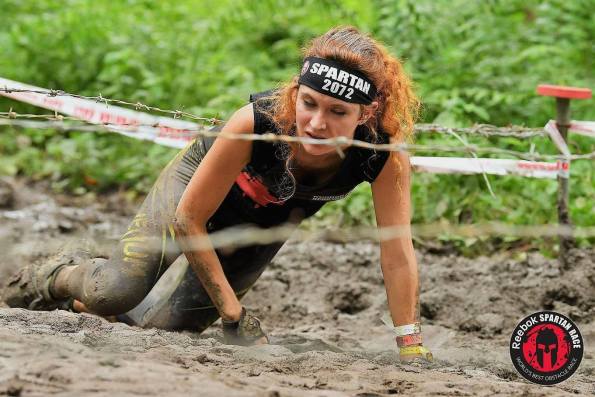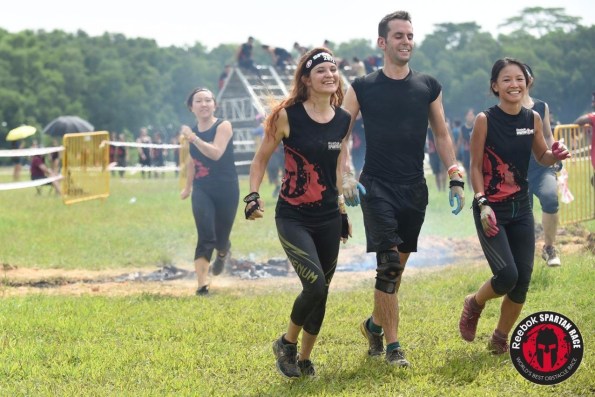I had this in mind for a while: a Spartan Race , as “commercial” has become the concept, still represents a nice physical challenge , and I wanted to test my own abilities to face it. I took my bib a year ago, in 2016, for that of June in France. And then I suddenly moved to Singapore and in the end couldn’t participate. Except that the organization is global and it also runs in Singapore. So I took my place straight away, in Sprint and Open , and not really knowing what to expect. Like everyone else, I had seen the videos (the teaser is at the bottom of the article, if you’ve never seen it) but never faced the watch obstacle – in my life, in made. Since I know some people would like to run one too, here’s my take on the Spartan Races and whether or not you should try running one too!
1. What is a Spartan Race?
It’s the most popular obstacle course in the world. The concept was launched in 2007 by a group of Americans, and has been sponsored since 2012 by Reebok
It’s a sporting race , (the participants are timed and the goal is to finish as quickly as possible – and without possibly getting injured) which alternates pure racing and obstacles of military inspiration . Crawling under barbed wire, carrying logs or blocks of stone, climbing smooth ropes, jumping over barricades: a whole bunch of movements that you don’t really do on a daily basis (unless you’re a marine) , and not even really at the gym (unless you’re crazy motivated).
There are several types of routes, the most famous of which are:
- Sprint – minimum 5km and between 20 and 23 obstacles
- Super – minimum 12.8km and between 24 and 29 obstacles
- Beast – minimum 19.3km and and between 30 and 35 obstacles
I say minimum, because it really depends on the terrain too. the Singapore Sprint, and I’ll talk about it a little later, was 8km this year)
We have to face all the obstacles, and if we fail on one of them, the “punishment” is the same for everyone: 30 burpees , that must finish before you can continue on your way.
Obviously, the difficulty is increasing, and if we manage to complete the 3 (Sprint, Super and Beast) over a calendar year, we are talking about winning the “ Trifecta “.
For each race won, you receive a round medal, and a 1/3 medal, which must be added to the 2 of the other two types of races to make a big full medal. (It’s anecdotal, but I find the principle really cool.)
Note that there are Ultra versions (over a marathon distance, 42km) and also more occasional operations, and in particular events reserved for the army in the USA.
What is the difference between Open and Elite?
The Elite category is competitive: we are not allowed to receive help on obstacles and the best runners win prizes.
The Open category is more free, and we have the right to help each other to pass certain obstacles if necessary (the little ones will be carried, the logs will be carried in pairs instead of alone, etc.). So you have to have people you can count on in the area.
2. What was the first Spartan Race like?
I imagine if you read to yourself everything on their site about obstacles, if you do the trainings they recommend and you have the opportunity to go and test the obstacles (they sometimes organize special training), it must be a lot less fuzzy than it was in mine when I started. I’m the type to put my head in the sand before I face the difficulty (I was the type to refuse to re-read my copies, that sort of thing) so I completely refused to inquire. Well. So on race day I was 1. very stressed, 2. not at all aware of what was going to happen. eh eh.

What does the terrain look like?
The Singapore Spartan sits half on a huge, flat sports field, half in the forest. It hadn’t rained for a very long time, so they flooded the whole thing just to make a big, thick mud over a big chunk of the course – for the waste, we’ll come back. Obviously mud is a necessary part of the concept, so be prepared to find it where you run .. and roll in it.
What is the starting village like?
It looks like a normal running village: food stalls and sports clothes, (very few branded gift stands), and then a whole bunch of people with the same Reebok t-shirt – well 2 kinds , rather: those, all clean, beautiful and all stressed in their racing t-shirts, who are waiting for the start of their wave, and the really really disgusting full of mud, with the t-shirts of finishers, who bear a slightly dirty medal but a glorious, relieved smile.
we have to take / put what?
I was optimistic and put on new sneakers. However, the presence of large trash bags full of shoes at the exit of the race was a major clue: the sneakers are struggling to survive. We therefore put on shoes at the end of their life.
We opt for long, tight-fitting synthetic sports pants (sports leggings, what?) and high socks – the goal is to avoid burns and splinters and cuts and … in short. The injuries, what. Also put on gloves (for training if you have, but gardening also works) because you put your hands a lot on the ground / on wooden things / on things not made to put your hands on. And that makes the rope events A LOT easier.
Finally, we forget all personal effects (there is enough to put down our bag, so no worries) because to be cluttered is to slow down. There’s water distributed along the way, so just his … and his knife, and you’ll be fine!
Once launched, what happens?
The race itself … From an absolute beginner, then, I discovered the obstacles as I went, which also allowed me not to worry up front. Once we get started, it’s too late, and we find a way to get past the obstacles. Considering my composition, all the obstacles that called for pure strength from the arms and back were more complicated than the others. I only did the 30 burpees once, after a failure on the rope – which was at the end of the course as a bonus.
And what do you do when you don’t have a team?
I have to admit that I was a little optimistic going alone. I realized during the race that I was going to need some help. I was lucky enough to come across a very nice team (2 young men and a young lady) with whom I was able to associate – and they have even become very good friends since (because suffering together, it creates links for sure!). They carried me (or at least propelled me) over 2 obstacles. That’s also it, being 5’8 and thinking you’re a Spartan.
How did it end?
Very, very well. And with a beer too, offered at the finish line. We had our time a few days later, and I didn’t think I had done so well: 1h41 to finish the course, in the top 7% of the Open Sprint (140th out of 2000 and wheelbarrows). I have a nice medal, 2 nice Reebok t-shirts… and an almost validated registration for the Super which is being held in Malaysia in 2 months.

3. Do YOU have to run a Spartan Race?
Enough about me, if you’re reading this then you want to run one too.
I really think it’s a very, very nice physical challenge. On the other hand, I would advise against it for complete beginners, who don’t usually run at all (I’m not a big runner, but 8km, you still have to hold them, even if you have the possibility of walking if it really doesn’t go well. plus) and those who never train for bodyweight – you still have to climb stuff and wear other stuff, and that takes a bit of muscle and body knowledge.
For all the others, occasional or experienced sportsmen and women: GO FORWARD. It’s a really great experience, all the runners are in the same boat so we share a moment with hundreds of people, and we are very, very proud once we cross the finish line. At worst, you’ll be doing a lot of burpees, but if you decide to give the Sprint a try, there’s no reason not to finish it. It makes a lot of aches the next day (and for a big week, actually) but it mostly makes some cool memories and it revives any motivation.
